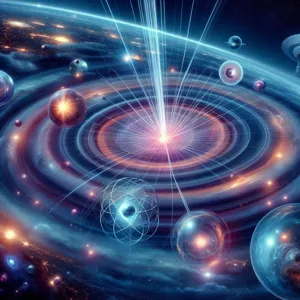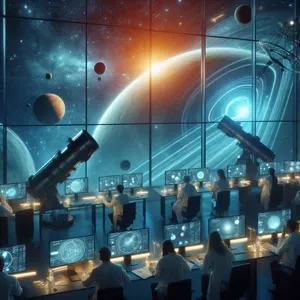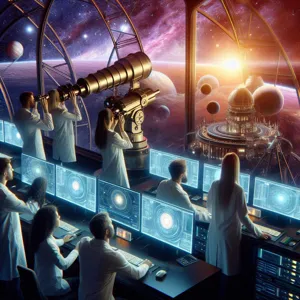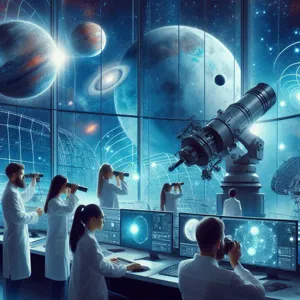The universe is a vast tapestry of celestial wonders, and at its heart lies the intriguing question of what makes each planet unique.
For astronomers, unraveling the mysteries of planetary composition is not just a scientific pursuit; it’s a journey into the very fabric of the cosmos. From the fiery depths of Venus to the icy rings of Saturn, understanding the materials and elements that compose these distant worlds can reveal critical insights into their formation, evolution, and potential for harboring life. In this blog post, we’ll explore the cutting-edge techniques and technologies that astronomers use to analyze planetary makeup—from spectroscopy that decodes light signatures to advanced space missions that gather data from afar. Join us as we unlock the secrets of the universe, one planet at a time, and discover how these cosmic detectives piece together the building blocks of our solar system and beyond.
1. Introduction to Planetary Composition

The study of planetary composition is a fascinating intersection of chemistry, physics, and astronomy, revealing the intricate details of celestial bodies that orbit our Sun and other stars across the universe. Understanding what planets are made of not only helps astronomers classify these bodies but also provides insights into their formation, evolution, and potential for hosting life.
At its core, planetary composition examines the materials that make up a planet—ranging from its core to its crust, and even its atmosphere. Scientists categorize these materials into various elements, minerals, and compounds, each contributing to the planet’s unique characteristics. For example, terrestrial planets, like Earth and Mars, are primarily composed of rock and metal, whereas gas giants, such as Jupiter and Saturn, are predominantly made up of hydrogen and helium, with swirling atmospheres of various gases.
The methods used to analyze planetary composition are as diverse as the planets themselves. From spectroscopy, which analyzes the light emitted or absorbed by a planet to determine its chemical makeup, to mass spectrometry, which measures the masses of different elements present, astronomers have developed a suite of tools to unlock the secrets of these distant worlds. By studying the reflected light from a planet’s surface or the chemical signatures in its atmosphere, scientists can gain a deeper understanding of its geology, climate, and potential habitability.
In this blog post, we will explore the significance of planetary composition in astronomy, the techniques employed by astronomers to analyze it, and the implications of these findings in our quest to understand the universe and our place within it. As we embark on this cosmic journey, we’ll uncover the mysteries that lie within the celestial bodies that fascinate humanity and drive our scientific exploration.
2. The Importance of Analyzing Planetary Composition
Understanding the importance of analyzing planetary composition is akin to uncovering the secrets of the universe. Each celestial body, from rocky planets like Earth and Mars to gaseous giants such as Jupiter and Saturn, holds vital clues about its history, formation, and potential for supporting life. By scrutinizing the materials that make up these planets, astronomers can not only piece together the processes that shaped our solar system but also extend their knowledge to exoplanets in distant star systems.
The composition of a planet reveals much about its geological activity, atmosphere, and climate. For instance, the presence of certain elements can indicate volcanic activity or tectonic movements, while the composition of the atmosphere can provide insights into weather patterns and the potential for habitability. A planet rich in carbon dioxide may have a very different climate than one dominated by nitrogen or oxygen. By studying these elements, astronomers can infer whether a planet could support life, or if it has ever had conditions conducive to life in its past.
Furthermore, analyzing planetary composition allows scientists to compare and contrast different worlds, leading to a greater understanding of the diversity of planetary systems. Identifying common materials across various planets helps refine theories about how planets form and evolve. This comparative analysis is crucial, especially as telescopes and instruments become more advanced, enabling the detection of smaller, Earth-like exoplanets orbiting distant stars.
In essence, the analysis of planetary composition is a key that unlocks the door to understanding not only our cosmic neighborhood but also the broader universe. As we piece together the puzzle of planetary materials, we inch closer to answering fundamental questions about the origins of the solar system, the potential for life beyond Earth, and the mechanics of planetary evolution throughout the cosmos.
3. Techniques for Gathering Data: Telescopes and Space Probes

In the quest to understand the intricate tapestry of planetary compositions, astronomers employ a variety of sophisticated techniques for gathering data, with telescopes and space probes serving as their primary instruments. Each method offers unique insights, shedding light on the elemental and molecular makeup of celestial bodies.
Telescopes, both ground-based and space-bound, are the astronomer’s first line of defense in the exploration of distant worlds. Equipped with advanced spectrometers, these powerful instruments analyze the light emitted or reflected by planets and their atmospheres. By examining the spectrum of light, scientists can identify specific wavelengths absorbed by different elements and compounds. For instance, the presence of methane might reveal itself through a distinct absorption line, while other elements like hydrogen or helium can be detected through their unique spectral signatures. Space-based telescopes, such as the Hubble Space Telescope and the upcoming James Webb Space Telescope, provide an unobstructed view of the cosmos, free from the distorting effects of Earth’s atmosphere, allowing for more precise measurements.
On the other hand, space probes offer a more intimate and detailed perspective of planetary bodies. These robotic explorers travel through the solar system, collecting in-situ data that ground-based observations simply cannot achieve. Probes like NASA’s Voyager and Juno missions have provided invaluable information about the gas giants, revealing not only their atmospheric compositions but also their magnetic fields and radiation environments. Some missions, like the Mars rovers, are designed to analyze soil and rock samples directly, providing insights into the geological history and elemental makeup of the Martian surface.
The synergy between telescopes and space probes creates a comprehensive toolkit for astronomers. While telescopes offer a broad view of the universe, helping identify promising targets for further study, space probes delve deeper, providing the intricate details needed to unlock the secrets of planetary composition. Together, these techniques pave the way for a deeper understanding of our solar system and beyond, illuminating the processes that shape the worlds around us. Through their relentless pursuit of knowledge, astronomers continue to unlock the mysteries of the cosmos, one observation at a time.
4. Spectroscopy: Understanding Light and Chemical Signatures
Spectroscopy stands as one of the most powerful tools in the astronomer’s toolkit, allowing scientists to delve deep into the composition of planets and celestial bodies without ever leaving Earth. At its core, spectroscopy is the study of how light interacts with matter. When light from a star or a distant planet passes through or reflects off its atmosphere, it carries with it invaluable information about the chemical elements and compounds present.
As light travels, it can be absorbed or emitted at specific wavelengths by various elements, creating a unique spectral fingerprint. This fingerprint appears as a series of dark lines or bright lines on a spectrum, each corresponding to particular wavelengths of light that are absorbed or emitted. By analyzing these spectral lines, astronomers can determine not only the presence of certain elements—such as hydrogen, helium, and carbon—but also their abundance and physical conditions, such as temperature and pressure.
For instance, when studying an exoplanet’s atmosphere, astronomers utilize space-based telescopes equipped with advanced spectrometers. These instruments can capture the light from the planet as it passes through its atmosphere during transit in front of its parent star. The resulting spectrum reveals insights into the gases surrounding the planet, helping scientists identify potential markers of habitability or even signs of alien life.
Moreover, spectroscopy isn’t just limited to identifying elements; it can also provide information about molecular compounds. By examining the specific wavelengths of light that are absorbed or emitted by molecules like water vapor or methane, researchers can infer the chemical processes occurring on a planet’s surface or in its atmosphere.
In summary, spectroscopy serves as a bridge between light and chemistry, unlocking the secrets of planetary composition. Through this intricate dance of light, astronomers continue to enhance our understanding of the cosmos, revealing the diverse and dynamic makeup of worlds beyond our own.
5. The Role of Remote Sensing in Planetary Analysis

Remote sensing has revolutionized the way astronomers analyze planetary composition, offering insights that were once confined to the realm of science fiction. This powerful tool enables scientists to gather extensive data about celestial bodies from vast distances, utilizing a variety of techniques and technologies to unveil the mysteries of the universe.
At the heart of remote sensing are sophisticated instruments, such as spectrometers and imaging systems, which can detect and analyze the electromagnetic radiation emitted or reflected by planets. By studying the light spectrum, astronomers can determine the chemical makeup of a planet’s surface and atmosphere. For instance, specific wavelengths can indicate the presence of water vapor, carbon dioxide, or other key elements, providing invaluable clues about a planet’s habitability and geological history.
One of the most significant advancements in remote sensing is the use of space-based telescopes and orbiters. These instruments, positioned outside of Earth’s atmosphere, can capture high-resolution images and spectra without the interference of atmospheric distortion. Missions like NASA’s Mars Reconnaissance Orbiter and the European Space Agency’s Venus Express have provided detailed maps of planetary surfaces, revealing varied terrains, weather patterns, and even hints of past water activity.
Furthermore, remote sensing extends beyond our solar system. Telescopes equipped with advanced technology, such as the James Webb Space Telescope, allow for the analysis of exoplanet atmospheres by observing the starlight that passes through them during transits. This method has opened new frontiers in the search for potentially habitable worlds beyond our own.
In summary, the role of remote sensing in planetary analysis is crucial, enabling astronomers to piece together the intricate puzzle of planetary formation, evolution, and composition. As technology continues to advance, the potential for discovering new worlds and understanding their characteristics expands, bringing us closer to unlocking the secrets of the cosmos.
6. Analyzing Atmospheres: Gas Composition and Dynamics
Analyzing the atmospheres of distant planets is a captivating endeavor that allows astronomers to unveil the intricate dance of gases that envelop these celestial bodies. By utilizing a variety of advanced techniques, scientists can dissect the chemical makeup and dynamic behavior of these atmospheres, revealing critical insights into the conditions that prevail on these distant worlds.
One of the primary methods used in this analysis is spectroscopy, where light from a star passing through a planet’s atmosphere is studied. As light filters through the gases, it interacts with the molecules, producing unique spectral fingerprints that reveal the presence of specific elements and compounds. For instance, the detection of water vapor, methane, or carbon dioxide can indicate potential habitability or the presence of geological activity. These spectral signatures not only help identify the gas composition but also hint at the processes at work, such as photochemical reactions or volcanic activity.
Moreover, astronomers examine the dynamics of planetary atmospheres by monitoring changes over time. Techniques like transit photometry allow researchers to observe how the light from a star dims as a planet crosses in front of it, providing crucial data about the planet’s size and orbital characteristics. By combining this information with models of atmospheric circulation, scientists can infer wind patterns, temperature gradients, and even seasonal changes. For example, on the gas giant Jupiter, powerful storms and jet streams are meticulously studied, offering clues about the underlying physics at play.
As technology continues to advance, telescopes equipped with high-resolution instruments are becoming increasingly adept at probing the atmospheres of exoplanets. With missions such as the James Webb Space Telescope poised to delve deeper into the cosmos, the potential to unlock the secrets of planetary atmospheres is greater than ever. The insights gained from these analyses not only enhance our understanding of distant worlds but also enrich our knowledge of Earth’s own atmospheric dynamics, paving the way for a deeper appreciation of the universe we inhabit.
7. Surface Composition: Methods and Instruments

Understanding the surface composition of celestial bodies is a crucial aspect of planetary science, providing insights into their formation, evolution, and potential for hosting life. Astronomers employ a variety of sophisticated methods and instruments to analyze the materials that make up a planet’s surface, each offering unique advantages and challenges.
One of the primary techniques used is spectroscopy, which involves analyzing the light reflected or emitted by a planet’s surface. By studying the spectrum of this light, astronomers can identify the chemical signatures of various minerals and compounds. Instruments like the Visible and Infrared Imaging Spectrometer (VIR) on the European Space Agency’s ESA’s Venus Express and the Near Infrared Spectrograph (NIRSpec) aboard the James Webb Space Telescope have been pivotal in revealing the composition of planetary surfaces, from the rocky terrains of Mars to the icy crusts of distant moons.
Another method employed is remote sensing, which involves gathering data from a distance, often using satellites or space probes. These instruments can capture high-resolution images that highlight surface features and variations in color and texture, providing clues about the underlying materials. For example, NASA’s Mars Reconnaissance Orbiter has been instrumental in mapping the Martian surface, revealing diverse geological features and helping scientists infer the presence of water ice and past volcanic activity.
In addition to these remote methods, in-situ analysis—where instruments are sent directly to a planetary surface—offers a more detailed understanding of composition. Rovers like NASA’s Curiosity and Perseverance have been equipped with advanced laboratories capable of conducting chemical analyses, taking soil samples, and measuring mineral content. This hands-on approach allows for precise measurements and has led to groundbreaking discoveries, such as the detection of organic molecules and the identification of ancient riverbeds on Mars.
By combining these various methods, astronomers can create a comprehensive picture of a planet’s surface composition. This multi-faceted approach not only enhances our understanding of individual celestial bodies but also helps scientists draw broader conclusions about planetary formation and the potential for habitability throughout the cosmos. As technology continues to evolve, the methods and instruments used to analyze planetary surfaces will undoubtedly grow more sophisticated, unlocking even more secrets of our universe.
8. The Significance of Meteorites in Understanding Planetary Origins
Meteorites serve as celestial time capsules, offering astronomers invaluable insights into the building blocks of our solar system and the origins of planetary bodies. These fragments, which have journeyed through the vast expanse of space to land on Earth, are remnants of the early solar system that can reveal a wealth of information about planetary formation and evolution.
When a meteorite crashes into our atmosphere, it carries with it a unique story of its parent body—whether it be a planetesimal, asteroid, or even a larger celestial body. By studying their chemical composition, isotopic ratios, and mineralogical structures, scientists can glean critical details about the conditions under which these materials formed. For instance, certain isotopes can indicate the temperature and pressure at the time of formation, while the presence of specific minerals may point to processes such as differentiation, where heavier materials sank to a body’s core while lighter materials formed its crust.
Moreover, meteorites can provide a direct comparison to the materials found on other planets and moons. For example, the analysis of Martian meteorites has shed light on the geological history of Mars, suggesting the presence of water and hinting at past habitability. Similarly, the study of lunar meteorites has enhanced our understanding of the Moon’s surface processes and its relationship with Earth.
The significance of meteorites extends beyond mere analysis; they serve as a bridge to understanding the broader cosmological narrative. Each meteorite is a fragment of a larger puzzle, contributing to our comprehension of how planets form, evolve, and interact with one another. As astronomers continue to unlock the secrets held within these ancient rocks, they are not just piecing together the story of our solar system, but also exploring the potential for life beyond our home planet. In this way, meteorites are not merely remnants of the past; they are keys to understanding our cosmic origins and the processes that govern planetary systems across the universe.
9. Case Studies: Analyzing the Composition of Mars and Venus
In the quest to understand our solar system, Mars and Venus stand out as two fascinating case studies, each offering a unique glimpse into the composition and geological history of terrestrial planets. As astronomers delve into the rich tapestry of these neighboring worlds, they utilize a variety of advanced techniques to uncover their secrets.
### Mars: The Red Planet’s Mysteries
Mars, often referred to as the Red Planet, is a prime candidate for studying planetary composition due to its relatively accessible surface and wealth of data collected from rovers and orbiters. The Mars Reconnaissance Orbiter (MRO) has been instrumental in mapping the planet’s surface, employing spectrometry to analyze its mineral composition. From the presence of iron oxide giving Mars its distinctive reddish hue to the detection of hydrated minerals indicating past water activity, MRO has painted a picture of a world that was once warmer and wetter.
Further insights come from the Perseverance rover, which not only explores the surface but also collects rock samples that will eventually return to Earth for detailed laboratory analysis. The rover’s instruments, like the PIXL (Planetary Instrument for X-ray Lithochemistry), examine the elemental makeup of Martian rocks at a microscopic level. By piecing together this information, scientists can infer the planet’s volcanic history and assess its potential for past microbial life.
### Venus: The Veiled World
In contrast, Venus presents a harsher environment, with its thick, toxic atmosphere and extreme surface temperatures. However, this does not deter astronomers from studying its composition. Data gathered from the European Space Agency’s Venus Express and NASA’s Magellan orbiter has provided a wealth of information about the planet’s surface and atmosphere. Using radar mapping and infrared spectroscopy, researchers have identified volcanic plains, mountainous regions, and the presence of sulfuric acid clouds that obscure the planet’s surface from direct observation.
One of the most intriguing aspects of Venus is its geological activity. The detection of volcanic features and the absence of impact craters suggest a relatively young surface, indicating that the planet may still be geologically active. By analyzing the mineral composition through remote sensing and studying the atmosphere’s chemical makeup, astronomers continue to unravel the complexities of Venus, drawing parallels and contrasts to Earth’s own geological history.
### Conclusion
The analysis of Mars and Venus not only sheds light on their individual compositions but also enriches our understanding of planetary formation and evolution in our solar system. As technology advances, the ability to analyze these worlds will continue to improve, paving the way for future discoveries that could redefine our knowledge of planetary science and potentially reveal new insights into the conditions that foster life beyond Earth.
10. The Role of Computer Simulations in Planetary Composition Analysis
In the quest to understand the intricate makeup of distant planets, computer simulations have become an indispensable tool for astronomers and planetary scientists. These simulations allow researchers to create detailed models of planetary formation and evolution, providing insights that would be impossible to glean from observation alone. By simulating the conditions of the early solar system or other exoplanetary environments, astronomers can explore how various factors, such as temperature, pressure, and chemical composition, influence the development of a planet’s atmosphere and surface.
Computer simulations serve multiple purposes in planetary composition analysis. Firstly, they enable scientists to test hypotheses regarding how planets form from the residual material left over after star formation. By manipulating variables within these models, researchers can observe how different elements and compounds interact over time, effectively recreating the conditions under which planets are born. This helps in identifying the primary components of a planet’s atmosphere, surface minerals, and even potential geological activity.
Moreover, simulations can assist in interpreting data gathered from telescopes and space missions. For instance, when observing the spectrum of a distant planet’s light, astronomers can use simulation models to compare the observed data against various compositions. This process allows them to infer what materials are present on the planet, whether it’s water vapor, carbon dioxide, or exotic compounds unique to that environment. The ability to visualize these scenarios fosters a deeper understanding of planetary systems, revealing how they might differ from our own and what that implies for the potential for life beyond Earth.
As technology progresses, the sophistication of these simulations continues to grow. Advanced algorithms and high-powered computing resources permit the modeling of increasingly complex scenarios that take into account factors like cosmic radiation or magnetic fields. This fusion of computational power with observational data is not only revolutionizing our understanding of planetary bodies but also paving the way for future discoveries in the ever-expanding cosmos. Ultimately, computer simulations are not just a tool; they are a crucial ally in the astronomer’s quest to unlock the mysteries of planetary composition and the universe itself.
11. Collaborative Efforts: International Research and Data Sharing
In the vast and ever-expanding field of astronomy, collaboration has become the cornerstone of significant advancements in our understanding of planetary composition. As celestial bodies beyond our solar system become the targets of intense scrutiny, the complexity of analyzing their unique characteristics necessitates a collective approach. International research initiatives and data-sharing agreements among astronomers, planetary scientists, and institutions from around the globe have transformed the way we study the cosmos.
These collaborative efforts often begin with large-scale projects, such as the European Space Agency’s (ESA) missions or NASA’s extensive planetary exploration programs. Researchers from various countries come together to pool resources, expertise, and technological innovations, allowing for a more comprehensive analysis of distant worlds. By leveraging a diverse set of instruments—from ground-based observatories to space telescopes—scientists can cross-reference findings and validate their hypotheses, enriching our understanding of planetary atmospheres, compositions, and potential habitability.
Data sharing plays a pivotal role in this collaborative landscape. Astronomers utilize platforms like the NASA Exoplanet Archive and the European Southern Observatory’s databases to access a wealth of observational data collected from various missions. This open exchange not only accelerates the pace of discovery but also fosters a spirit of transparency and inclusivity within the scientific community. By making data accessible to researchers worldwide, we encourage innovative analyses and interpretations that might not have been possible in isolated settings.
Moreover, international conferences and workshops serve as vital platforms for knowledge transfer, where scientists discuss their latest findings, share methodologies, and brainstorm new research directions. These gatherings often lead to the formation of new partnerships, further amplifying the collaborative momentum in the quest to decode the mysteries of our universe.
In essence, the complex tapestry of planetary composition analysis is woven together through the threads of collaboration and shared knowledge. As astronomers continue to work hand-in-hand across borders, the insights we gain into the nature of distant planets will not only broaden our understanding of the cosmos but may also illuminate the potential for life beyond our own Earth. Through these collective endeavors, we are not only unlocking the secrets of the universe but also fostering a global community united by the pursuit of knowledge.
12. The Impact of Planetary Composition on Habitability
Understanding the impact of planetary composition on habitability is a crucial aspect of astrobiology and planetary science. As astronomers delve deeper into the cosmos, they encounter a fascinating array of celestial bodies, each with its unique chemical makeup that can significantly influence its potential to support life.
At the core of habitability lies a planet’s atmosphere, which is shaped by its composition. For instance, the presence of key elements such as carbon, oxygen, and nitrogen can pave the way for a stable atmosphere conducive to life as we know it. A planet rich in these elements is more likely to develop water in liquid form, a fundamental requirement for life. In contrast, a planet devoid of these crucial components may struggle to maintain an atmosphere, rendering it inhospitable.
Moreover, the geological characteristics of a planet—its mineral composition, surface features, and tectonic activity—also play a vital role in determining habitability. For example, a planet with a dynamic geology may facilitate nutrient cycling and energy flow, which are essential processes for sustaining life. In this context, astronomers utilize spectroscopic techniques to analyze the light reflected off a planet’s surface, revealing its elemental and mineralogical composition. This data helps them infer whether geological activity could create a stable environment for life.
Temperature is another critical factor influenced by planetary composition. A planet’s distance from its star determines its ability to retain heat, but the type of materials constituting its surface can also affect its thermal properties. For example, rocky planets may have varying heat retention abilities based on their mineral makeup, which in turn influences surface temperatures and, consequently, the likelihood of liquid water existing on its surface.
In the quest for extraterrestrial life, scientists are particularly interested in identifying exoplanets within the “habitable zone” of their stars—regions where conditions might be just right for life. However, it’s not merely location that matters; the intrinsic characteristics of these planets, dictated by their composition, are equally important. This multifaceted approach allows astronomers to create a more nuanced picture of potential habitability across the universe.
As we continue to unlock the secrets of planetary composition, we move one step closer to answering one of humanity’s most profound questions: Are we alone in the universe? The analysis of planetary materials not only enriches our understanding of the cosmos but also fuels our curiosity about the possibility of life beyond Earth.
13. Future Trends in Planetary Analysis Technology
As we stand on the brink of a new era in astronomical exploration, the future of planetary analysis technology promises to revolutionize our understanding of the cosmos. Emerging advancements are set to enhance the precision and scope of how astronomers study planetary compositions, enabling us to unveil the secrets of distant worlds with unprecedented clarity.
One of the most exciting trends is the integration of artificial intelligence (AI) and machine learning into data analysis processes. These technologies can process vast amounts of spectral data much faster than human researchers, identifying patterns and anomalies that might go unnoticed. By employing AI algorithms, astronomers can not only enhance the accuracy of elemental detection on exoplanets but also predict atmospheric conditions and surface compositions with remarkable reliability.
Another significant trend is the development of next-generation space telescopes and probes. Upcoming missions, such as the James Webb Space Telescope, are designed to peer deeper into the universe and gather detailed information about the atmospheres of distant exoplanets. These instruments will utilize advanced spectrometry techniques that allow for the detection of specific molecules, such as water vapor, methane, and carbon dioxide, which are crucial indicators of habitability.
Additionally, improvements in in-situ analysis tools—devices designed to analyze planetary materials directly on the surface of celestial bodies—are on the horizon. Robotic landers and rovers equipped with state-of-the-art spectrometers and chemical analyzers will enable scientists to conduct comprehensive analyses of soil, rocks, and atmospheric samples from planets and moons within our solar system. This direct data collection could provide insights into the geological and chemical processes that shape these worlds, enhancing our understanding of their potential for life.
Moreover, collaborations between astronomers and data scientists are becoming more prevalent. By merging expertise from various fields, researchers can develop innovative methodologies that push the boundaries of planetary analysis. This interdisciplinary approach fosters creativity and could lead to groundbreaking discoveries that challenge our existing notions of what constitutes a planet and the conditions necessary for life.
In summary, the future of planetary analysis technology is bright, with AI, advanced telescopes, in-situ analysis tools, and interdisciplinary collaborations leading the way. As these innovations unfold, we can expect a deeper understanding of not only our own solar system but also the countless planets that exist beyond it, ultimately unlocking the mysteries of the cosmos and our place within it.
14. Conclusion: The Journey Ahead in Cosmic Exploration
As we draw our exploration of planetary composition to a close, it becomes evident that the journey ahead in cosmic exploration is both thrilling and filled with potential discoveries. The advances in technology and techniques have revolutionized the way astronomers study distant worlds, allowing us to peer into the atmospheres of exoplanets, decipher the chemical signatures of their surfaces, and understand their potential for hosting life.
The future promises even more exciting developments. With the launch of next-generation telescopes and enhanced spacecraft missions, we can expect to glean deeper insights into the formation and evolution of planets across various solar systems. Missions like the James Webb Space Telescope are already paving the way for unprecedented observations, revealing details about the composition of exoplanet atmospheres and the presence of vital elements such as water and carbon, which are essential for life as we know it.
Moreover, the integration of artificial intelligence and machine learning in data analysis will allow astronomers to sift through vast amounts of data far more efficiently than ever before. By identifying patterns and anomalies that might escape human notice, these technologies will serve as indispensable tools in the quest to understand the cosmos.
As we stand on the cusp of this new era in astronomy, the potential for groundbreaking discoveries is immense. We will not only continue to unlock the secrets of our own solar system but also venture further afield to explore the myriad planets that populate our galaxy. Each discovery will bring us one step closer to answering profound questions about the universe and our place within it. The journey ahead is not just about understanding planetary composition; it’s about unraveling the mysteries of existence itself. As we look to the stars, we can only imagine the wonders that await us in the vast, uncharted expanse of the cosmos.
15. Additional Resources for Aspiring Astronomers and Enthusiasts
For those captivated by the wonders of the universe and eager to dive deeper into the world of astronomy, a wealth of resources is available to enhance your knowledge and skills. Whether you are an aspiring astronomer or a passionate enthusiast, these tools can help you broaden your understanding of planetary composition and the intricate processes that define our solar system and beyond.
**Books and Literature:** start your journey with some recommended reading. Titles like “Astrophysics for People in a Hurry” by Neil deGrasse Tyson or “Cosmos” by Carl Sagan offer accessible yet profound insights into the universe. For a more technical approach, consider “Planetary Science: A Lunar Perspective” by D.J. Tholen, which delves into the specifics of planetary bodies and their compositions.
**Online Courses:** Platforms like Coursera and edX offer free and paid courses on astronomy and planetary science, often taught by professors from renowned institutions. These courses provide structured learning, covering everything from the basics of celestial mechanics to advanced topics in planetary geology.
**Podcasts and YouTube Channels:** For on-the-go learning, podcasts such as “StarTalk Radio” or “Astronomy Cast” present intriguing discussions that make complex topics digestible. Similarly, YouTube channels like “PBS Space Time” or “Fraser Cain’s Universe Today” feature engaging videos that break down astronomical concepts and recent discoveries in an entertaining format.
**Astronomy software and Apps:** Consider utilizing software such as Stellarium or Celestia, which allow you to explore the night sky in real-time. These tools can help you visualize celestial events, track planetary movements, and even simulate different astronomical phenomena. Additionally, mobile apps like SkySafari or Star Walk make it easy to identify stars and planets right from your backyard.
**Astronomy Clubs and Field Trips:** Engaging with your local astronomy community can provide invaluable hands-on experience. Join clubs or attend workshops to meet fellow enthusiasts and gain access to telescopes and equipment. Local observatories often host public viewing nights, allowing you to explore the cosmos under the guidance of experienced astronomers.
**Research Journals and Websites:** To stay updated on the latest findings in planetary science, explore research journals such as “Icarus” or “Planetary and Space Science.” Websites like NASA and the European Space Agency offer a treasure trove of articles, mission updates, and data that can fuel your curiosity and inspire further investigation.
By leveraging these resources, aspiring astronomers and enthusiasts can deepen their understanding of planetary composition and the dynamic forces that shape our universe. Whether you’re gazing at the stars through a telescope or reading the latest scientific papers, the cosmos is waiting for you to unlock its many mysteries.
In conclusion, understanding how astronomers analyze planetary composition not only deepens our knowledge of the cosmos but also fuels our curiosity about the universe beyond our own planet. By employing a variety of innovative techniques, from spectroscopy to gravitational analysis, scientists can unlock the secrets held within distant worlds, revealing their atmospheres, potential for habitability, and unique geological features. As technology evolves and our observational capabilities expand, the mysteries of the universe will gradually unfold, offering us a clearer glimpse into the processes that shape celestial bodies. We invite you to stay engaged with this fascinating field, as each discovery adds a new piece to the cosmic puzzle and inspires future generations to explore the wonders of space. Thank you for joining us on this journey through the stars!




































